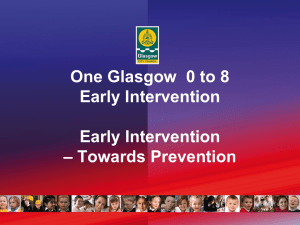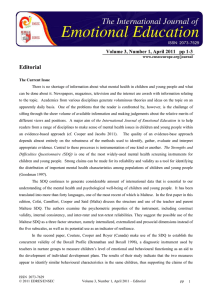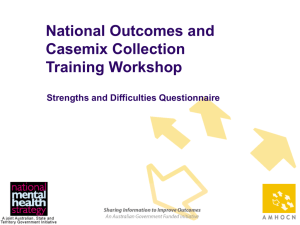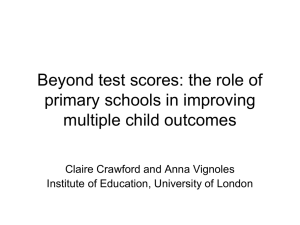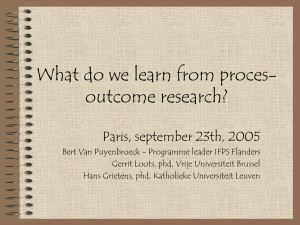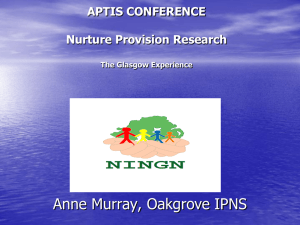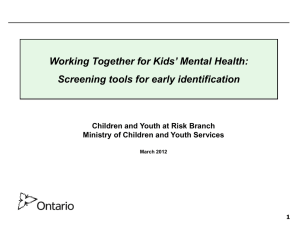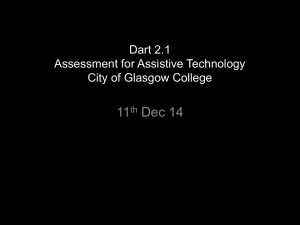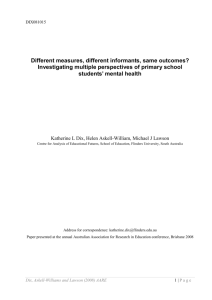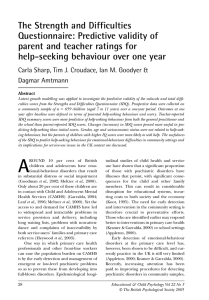5__lucy_thompson - The Institute for Research and Innovation in
advertisement
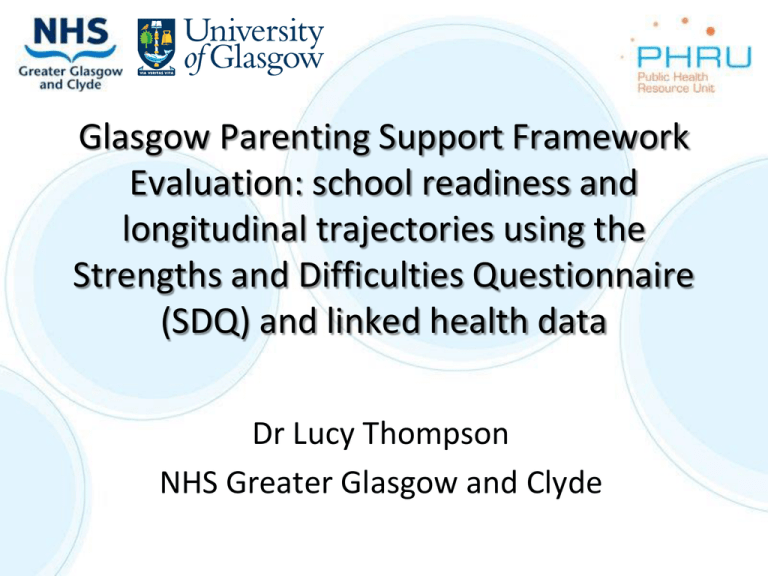
Glasgow Parenting Support Framework Evaluation: school readiness and longitudinal trajectories using the Strengths and Difficulties Questionnaire (SDQ) and linked health data Dr Lucy Thompson NHS Greater Glasgow and Clyde Glasgow Parenting Support Evaluation • Collaboration between NHS GGC, Glasgow City Council Education Services and University of Glasgow • Funded by Scottish Government • Involves whole population assessments of social and emotional development at ages 30 months, 5 years, 7 years and 10 years • Prime aim is service evaluation rather than research Key factors • Collaborative project – Local academic expertise – NHS input from a range of levels – Multidisciplinary / multiagency evaluation steering group • Evaluation administrative office • Coordination and communication – Regular meetings of admin staff – Regular contact with parenting coordinators Glasgow Evaluation Principles – Focus on measurable child-centred outcomes – Use standardised tools – Data should be useful for 4 purposes: • Professional decision making • Needs assessment • Performance management • External evaluation Research Questions (1) • What is the reach of /engagement with the Triple P programme (compared to projected population figures)? • In those families engaging with Triple P interventions, what is the short term impact in terms of reducing risk factors and increasing protective factors associated with poor or favourable developmental outcomes in children and young people? • Can we achieve our aim of 90% completion of pre- and post-intervention evaluation measures? Research Questions (2) • What is the pattern of emotional and behavioural difficulties in the population at 2.5, 5, 7 and 10 years? • What is the pattern of emotional and behavioural difficulties in a sample of the population at 12 to 16 years? • How do these patterns compare with national and international normative data? • Does this overall pattern change over time? • To what extent do difficulties experienced by individual children persist or change over time? • Do socio-demographic factors such as geographical area, relative deprivation and school influence trajectories of emotional and behavioural functioning? Research Questions (3) • To what extent are offers, uptake and completion of Triple-P and other interventions matched to the level of emotional and behavioural difficulties? • Are offers, uptake and completion of interventions influenced by socio-demographic factors, parents’ perceptions, belief systems, etc? • To what extent do offers, uptake and completion of interventions influence the persistence of difficulties? • What are the predictors of resolution of difficulties both among participants in parenting support interventions and more broadly? Research Questions (4) • To what extent is the population of parents aware of Triple P and other sources of parenting support? • What are the key lessons regarding the implementation process? • Do rates of child injury change over time? • Do numbers of children subject to child protection case conferences and looked after away from home change over time? Types of data • Routinely-gathered data on all children in Glasgow through: – the Child Health Surveillance System including data collected at the new universal contact at 30 months; – social work systems re. child protection, child placement, etc; and – Scottish Morbidity Record (SMR) data on child injury held centrally by NHS Scotland’s Information and Statistics Division (ISD) • Recently-instigated routinely-gathered data on emotional and behavioural wellbeing for children in the education system; • Process data – referral, uptake, completion information, as well as pre- and post-intervention questionnaire data and qualitative feedback from practitioners, stakeholders and parents. The Strengths and Difficulties Questionnaire – www.sdqinfo.org A brief behavioural screening questionnaire for 3-16 year olds. 3 versions – parent, teacher, self-complete Originally developed as a screening tool for psychological problems in children but can be used to assess change after interventions and can be used to compare the wellbeing of populations The SDQ 25 questions used to measure five aspects of the child’s development: • emotional symptoms • conduct problems • hyperactivity/inattention • peer relationship problems • pro-social behaviour Responses: “Not True”, “Somewhat True”, “Certainly True” Questions scores in each domain totalled and classified: unlikely to have problems / possibly has problems / likely to have problems Along with questions about impact of problems, if relevant SDQ data collection • At a new routine 30 month health check by health visitors – SDQ (parent version) and language • Before school entry (completed by nursery staff) • At primary 3 (age 7) (teacher complete) • At primary 6 (age 10) (self complete) x – data collection point Solid lines indicate cohorts within the life of this project Dashed lines project to future data collection (beyond this project) 2010: SDQ data at school entry only (cross-sectional time-specific only). 2011: SDQ data at school entry PLUS at 2.5 years (as above PLUS crosssectional time-series). 2012: SDQ data at school entry PLUS at 2.5 years PLUS at 7 and 10 years (as above PLUS longitudinal cohort). Single child trajectory – potential data Demographic info questionnaires SIMD routine records GROS CHS-PS SEEMIS SEEMIS? SEEMIS? SDQ@ 30m SDQ@ preschool SDQ@ 7 yrs SDQ@ 10 yrs birth teens Triple P interventions: offer referral uptake completion Local admin systems… Social work involvement Social work data systems SDQ at school entry For all children entering primary school in Glasgow, started in 2010 Completed by Child Development Officers as part of routine Transition Documentation Now available as a SEEMIS module Data will be linkable to NHS and GROS data A way to measure how all preschool services are performing? Response rates – 2010 “pilot phase” • Nursery-based data only so far • Data available for about 70% of Glasgow school entrants – about 3,300 in total • Good questionnaire completion rates • Some nurseries did not return data • Expect about 97% completion in 2011 SIMD09 using within-Glasgow ranks Data source: Bruce Whyte at GCPH Factors related to total SDQ score at school entry Scores adjusted for establishment and neighbourhood SIMD = Scottish Index of Multiple Deprivation (1=most deprived, 5=most affluent) Deprivation and SDQ subscales Analysis – future plans • Refining the maps – disentangling the impact of neighbourhood, deprivation and service use • Linkage of health and education data: plotting trajectories from 2 to 10 years • Identify effects of area, nursery, school, family on these trajectories • Design trials of interventions aiming to reduce inequalities Further evaluation of SDQ use • User perspectives – – – – Child Development Officers Heads of preschool establishments P1 teachers Primary head teachers • Checking against parental scores Interviews with nursery staff • Preliminary findings: – Helps to think about children’s social and emotional readiness for school, rather than just academic preparedness – Consistent with Curriculum for Excellence – looking at the ‘whole child’. – Concerns about parental consent & informing parents confidently – Concerns about committing any negative information about a child to ‘paper’ – Concerns the data wouldn’t be used Acknowledgements • Phil Wilson • Carolyn Wilson and the SG Child and Maternal Health Division • Amanda Kerr, John Butcher and Morag Gunion and City of Glasgow Education Services • Kim Jones & Kelly Chung • Bruce Whyte at Glasgow Centre for Population Health • Sarah Barry at Robertson Centre for Biostatistics • Scottish Government produced the socio-economic data and Scottish Neighbourhood Statistics provided the datazone information. lucy.thompson@ggc.scot.nhs.uk
